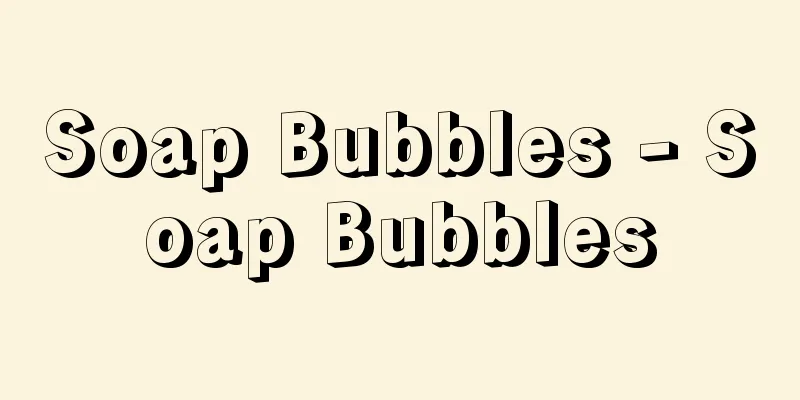Soap Bubbles - Soap Bubbles

|
When a thin tube made of wheat straw, bamboo, or vinyl is dipped in a liquid containing dissolved soap and blown into, water droplets fly into the air. Children play with blowing on it. If pine resin or glycerin is mixed into the solution, the colors of the polka dots become even more vibrant. It was introduced to Japan in the early 17th century, and its word is said to have its origin in the Portuguese word sabáo (soap). The Rakuyoshu, published in 1680 (Enpo 8), contains the poem "The sky is green, soap bubbles are blown, and the evening skylark flies by," which shows that it had already become a well-established Japanese game at that time. Furthermore, "Kiyu Shoran" (Kitamura Nobuyo), published in 1830 (Tenpo 1), records that in addition to soap, people also played with soap bubbles using powder made from roasted soapberry fruit, potato husks, and tobacco stalks, and writes that the Dutch called it sep, and that the Latin word savone became soap, and that this game of blowing bubbles was called suikengi. It also writes that it was popular among women, and peddlers went around selling it as a summer toy. "Morisada Manko" (Kitagawa Morisada), published in 1853 (Kaei 6), records that in Kyoto and Osaka, peddlers would say, "Blow bubbles, soap bubbles; when you blow, five-colored balls come out," and in Edo, "Balls, balls." Peddling disappeared after the Meiji period, but they are still sold as small toys and can be seen at street stalls at festivals. [Ryosuke Saito] In Kyoto and Osaka, he went around telling people, "Blowing bubbles, soap bubbles, five-colored balls come out when you blow them," and in Edo, he simply sold them by saying, "Tamaya, tamaya." "Morita Manko" Volume 6 "Occupation" (part) by Kitagawa Morisada, National Diet Library A soap bubble seller from the Edo period Source: Shogakukan Encyclopedia Nipponica About Encyclopedia Nipponica Information | Legend |
|
せっけんを溶かした液を、麦藁(むぎわら)、竹、ビニルなどの細い管につけて吹くと、空中に舞う水玉。子供が吹いて遊ぶ。溶液に松脂(まつやに)、グリセリンなどを混ぜると水玉はさらに鮮やかな色を放つ。17世紀の初め渡来したもので、ポルトガルのsabáo(せっけん)が語源という。1680年(延宝8)刊の『洛陽(らくよう)集』に、「空やみどりしゃぼん吹かれて夕雲雀(ひばり)」の句があり、当時すでに日本の遊びになりきっていたことを示している。また1830年(天保1)刊の『嬉遊笑覧(きゆうしょうらん)』(喜多村信節(きたむらのぶよ)著)では、シャボン以外にムクロジの実やいもがら、タバコの茎などを焼いた粉を材料に用いてシャボン玉遊びをしていることを記し、蘭(らん)人(オランダ人)はセップといい、ラテン語でサボーネというのがシャボンとなった、また玉を吹くこの遊びを水圏戯(すいけんぎ)という、とも書いている。女性の間でも流行し、夏の玩具(がんぐ)として行商が振れ売りに歩いた。1853年(嘉永6)刊の『守貞漫稿(もりさだまんこう)』(喜田川(きたがわ)守貞著)には、その振れ売りの文句を、京坂では「ふき玉やしゃぼん玉、吹けば五色の玉が出る」、江戸では「玉や玉や」と記している。明治以後行商は姿を消したが、現在も小物玩具として売られ、縁日の露店などでもみられる。 [斎藤良輔] 京坂では、「ふき玉やしゃぼん玉、吹けば五色の玉が出る」と触れ歩き、江戸では単に「玉や玉や」といって行商した。『守貞漫稿』 巻6 「生業」(部分) 喜田川守貞著国立国会図書館所蔵"> 江戸時代のシャボン玉売り 出典 小学館 日本大百科全書(ニッポニカ)日本大百科全書(ニッポニカ)について 情報 | 凡例 |
<<: Jamaica - Jamaica (English spelling)
>>: Manuscript painting - Shahonga
Recommend
Regular etiquette - Reijisahou
A Buddhist term. A ceremony held every evening at ...
Basile (English spelling) Giambattista Basile
Around 1575 - 1632 Italian poet and folk tale writ...
Tokyo Girls' School
Japan's first national girls' school was o...
Water rights
The right to use water exclusively and exclusivel...
Lilium longiflorum - Lilium longiflorum
An evergreen perennial plant of the lily family (...
metalanguage
...For example, a red light is understood by tran...
Dortmund-Ems Canal - Dortmund-Ems Canal
The canal stretches 269 km from Dortmund in centra...
Energy Metabolic Rate - Energy Metabolic Rate
A value that calculates how many times the basal m...
Charles Cressent
1685‐1768 A representative French cabinet maker, s...
ville
…In the United States, town means a small urban s...
Red-footed turtle - Red-footed turtle
...About 41 species are distributed in southern E...
Michaux, P.
…The first pedal-powered bicycle was invented in ...
Vampire
A monster that has been feared since ancient time...
Gasenshi (drawing paper)
A Japanese version of Chinese calligraphy paper. O...
Tadayoshi Ouchi - Ouchi Koreyoshi
Years of birth: unknown A military commander in th...









